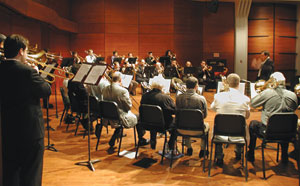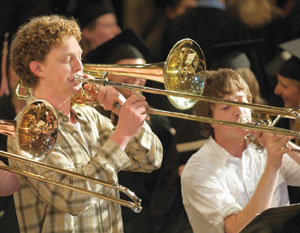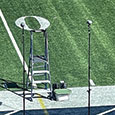Editor’s note: This gem from our archives ran in the September 1983 issue.
Most trombone playing, aside from individual practice, is done within a section. The best sounds and the most personal satisfaction come when players are keenly aware of the musical concepts that apply specifically to their section and have an understanding of how their section relates to the rest of the ensemble.

Balance and Blend
The trombones in a band or orchestra are usually scored in three parts that are played by two tenor trombones and one bass trombone, or multiples of that ratio. This three-part voicing is the most natural setting for trombones because it offers the best mixture of high and low frequencies. Just as superior stereo speakers must provide characteristic sounds with the right mixture of highs and lows, each musician in the section is responsible for providing an appropriate tone quality that will help the section sound its best.
Section blend, in addition to being a product of voicing, is also a result of volume. The first part usually predominates simply because it has the melody and is written in a higher range. However, absolute balance is not always desirable. Players should examine each passage within the context of both the section and the full ensemble to determine which voices, if any, should be heard above the others. In fact, section balance can change within a passage, such as when two parts sustain a tone and a third part moves. At these times it is desirable for the moving line to be heard above the others. Section players should always be checking for balance and asking what the music demands.
The second trombonist is the section’s messenger and mediator. Just as the bass trombonist welds the tuba to the trombone section, the second trombonist joins the first part to the bass; and this role requires a blending type of sound, one that contains fewer highs than the lead player’s and fewer lows than those from the bass. A good second player reacts quickly to what he hears, has a sound rich and full enough to blend with as well as heighten the other parts, and uses musical skills to help the others in the section. A section can be only as good as its second player; his individual limitations quickly become the limitations of the section.
Intonation
Tuning begins with the lower parts and moves to the higher voices because the lower voices often play the root and fifth of a chord. Composers usually seek an open sound, so they avoid placing notes close together in the lower pitch range where a muddy sound will result. Once the intonation of the fundamental intervals is established, the pitch of thirds, sixths, seconds, and sevenths becomes obvious. While individual chords are tuned from the bottom up, it is the pitch of the first part that is used as a link to the rest of the ensemble.
Players have to adjust their pitch to eliminate, as nearly as possible, the beats (a clash in the sound when two or more people play out of tune; the faster the beats, the more severe the problem). This is accomplished by moving the slide in a direction that first slows down, then finally eliminates the beat entirely. Having to tune every note by moving the slide in the same direction (always in or always out), is a sure sign that the main slide should be adjusted.
Pairs of players should get together on their own and learn what it sounds like to play in (and out of) tune, then try to shorten the time it takes them to recognize out-of-tune notes and adjust them. A word of caution: if a chord or a unison note is out of tune, try to change it immediately, but do not continue to fish around and call attention to the problem if the initial adjustment proves wrong. Instead, determine the proper adjustment and use it the next time you encounter the same chord or pitch.
The role of the bass trombone changes somewhat when the music is also scored for tuba. The two instrumentalists must work together to achieve one cohesive sound. The goal requires more than simply having the two players sit side by side. The bass trombone should sound like the first overtone of the tuba’s fundamental. This approach is especially important when two instruments are playing in octaves, which is frequently the case.
Intonation problems between these two parts may arise because of the differences in the construction of the instruments. The tuba is a conical valve instrument that is tempered to allow for pitch discrepancies with certain valve combinations. The bass trombone, on the other hand, is a cylindrical slide instrument built basically with natural (untempered) tuning, although it is tempered somewhat in the lead pipe so octaves and fifths are more in tune.
A certain amount of compromise is necessary to weld the tuba to the trombone section. For example, in order to play in tune with a CC tuba, the bass trombonist usually lowers B flats slightly and plays fifth position G-flat 2 and D-flat2, a bit lower than normal. Of course these adjustments vary depending on the players and their instruments. Good intonation requires good ears, a willingness to experiment, and the ability to compromise.
Articulation
Musical clarity should be the section’s goal in an effort to make obvious what the composer has written. Basically, a feeling of motion – moving the music forward – can act as a guide in selecting articulation. Sometimes it is necessary for the section to exaggerate articulations, especially in forte passages. In the following examples, the 16th note should be emphasized, for the sake of rhythmic clarity.

Repeated notes should be played in a slightly detached fashion to keep the music from bogging down. Passages that involve leaps are often performed incorrectly and are hear as though the lower note did not exist. Extreme care must be taken in passages that include both tongued and slurred notes, especially in large ensembles where clarity can be even more of a problem.
The bass trombonist must be somewhat flexible, adjusting the usual trombone articulation to a heavier quality when playing with the tuba. Again, the idea that the bass trombone should sound like the first overtone of the tuba’s fundamental is useful. The bass trombone can be thought of as creating the front part of the sound, while the tuba provides the round part of the sound. This is not to say that the bass trombonist should punch the notes while the tuba sustains them. Both players have to work together to produce a unified effect.
Legato passages are relatively easy for the trombone section to execute provided the musicians pay strict attention to playing with the beat. It does not matter if some members use a legato tongue, lightly tonguing every note, and others use natural slurs. A blended and balanced section is what counts.
Low brass players need to match their articulation to other sections in the ensemble, even though the nature of the slide make this difficult to accomplish. Careful listening and quick adjustments can help to make up for the basic difference in tone production techniques.

Keeping Time
One of the trombone section’s biggest problems is keeping good time. Low brass instruments tend to play behind the beat. The delay is caused partly by having the trombones sit in the rear of the ensemble, but is primarily the result of the instrument’s naturally slow response. It is important for the section to anticipate the beat and play as close to the beginning of it as possible, without rushing. Playing in the middle or near the end of the beat causes the section to sound late, and trying to catch up leads to other problems, such as forcing the tone. The trombones should not be told to play faster. The time between beats is exactly the same as for the rest of the ensemble; the trombone sound just needs to be started on the front part of the beat.
Of course, stylistic preferences can lead to different approaches. Performances of Bruckner’s music by European orchestras, for example, often feature low brass sections that play toward the end of the beat.
The section’s sound should be thought of as a cause of rhythmic activity in the ensemble, not an effect. Having the players breathe together is the best way to insure that the section will enter together. In experienced sections the principal player occasionally moves his instrument in a subtle manner when there is some question as to the proper placement of the beat; however, avoid having one or more players conduct with their slides. This technique can be useful when entering after a fermata or long rest, but the device is distracting and its overuse tends to undermine other section members’ confidence in their abilities. If your low brass section is consistently late, record a rehearsal and play back the results so the section can hear how it sounds and start making changes.
Large Ensembles
The problems of playing in a section are compounded when there is more than one person on a part. It is important in these instances that each section have its own principal player set standards for balance, blend, intonation, and articulation. During sectional rehearsals, the principals of each section should perform the parts, allowing every player to hear a balanced one-on-a-part sound and understand how each individual part fits into the sound of the section. Then different players should take turns playing in the trio. Weaker players will immediately recognize their own trouble spots, and stronger players will be able to hear and correct intonation problems as they occur.
An effective way of correcting problems during a full band rehearsal is to change the seating of the sections’ principal players, or to rotate the seating of others so everyone has a chance to sit next to the principal at some time. Imitation is one of the simplest yet most effective teaching devices at our disposal, and we should use it more often. Weak players should have the opportunity to hear strong players regularly. The best players should not all be placed on the first part, neither should they always be sitting next to the same players.
Another problem in many ensembles is the exclusive use of the tenor trombones with nearly identical bores, thus destroying the desired balance ratio of two tenors to one bass. Using larger mouthpieces for the lower parts is one way of alleviating this problem.
Balance, intonation, articulation, and rhythmic stability are important facets of playing well as a section. However, their importance lies in being used collectively to contribute to the life and clarity of the musical presentation. A worthy goal for every section of any ensemble is to emphasize musical images rather than individual personalities. By following the suggestions presented here, performing in a trombone section can provide a gratifying experience for the players, the ensemble, and the audience.





